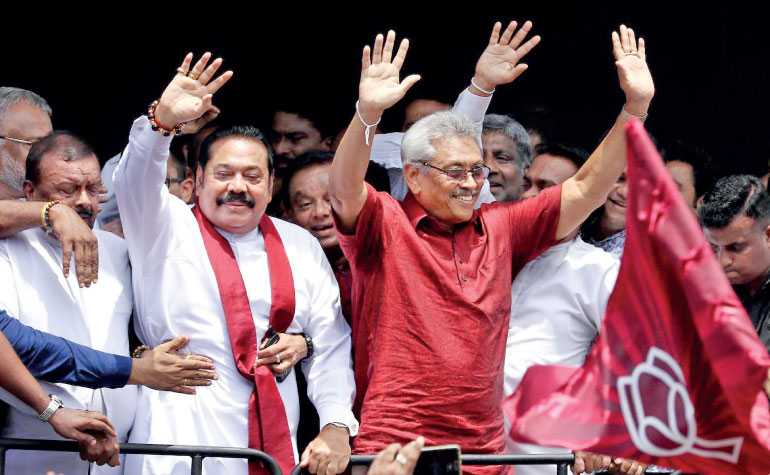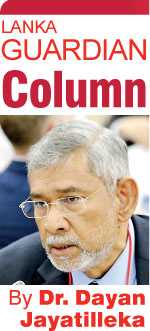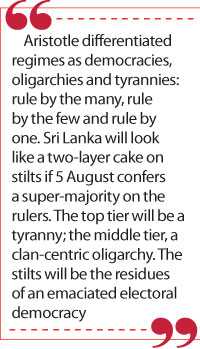Friday Jan 09, 2026
Friday Jan 09, 2026
Thursday, 16 July 2020 00:25 - - {{hitsCtrl.values.hits}}

President Gotabaya Rajapaksa is hoping for the rest of the Infinity Stones on 5 August 2020. They will ensure supreme and absolute power. His brothers are on an electoral expedition, assiduously seeking to acquire them for him
 An attitude of arrogant myopia; rejection of the outlook of scientific rationality; regarding intelligence-gathering as sufficient and downgrading scientific medical investigation/data collection/analysis (hence the Sri Jayewardenepura pullout); ignoring the Chief Epidemiologist-led, medical specialist-driven, globally acknowledged best practices constituting the managerial model of successful COVID-19 suppression; brusque contradiction of the warnings of the GMOA; a pandemic decisioning and command-and-control hierarchy in which medical expertise comes second to military/ex-military expertise; a personality cult of absurd exaltation (“world’s best anti-corona leadership”); a “Chosen People” ideology and absolutisation of the regime’s regionally relative success (“come to a corona-free country”); the deification of the military, attributing omniscience and conferring omnipresence (administrative and armed); and frequent executive placement of square pegs in round holes – with the squarest in the roundest – have cumulatively permitted a preventable, pluri-provincial proliferation of COVID-19, with army personnel figuring disproportionately as corona-afflicted/agency in the new wave or round.
An attitude of arrogant myopia; rejection of the outlook of scientific rationality; regarding intelligence-gathering as sufficient and downgrading scientific medical investigation/data collection/analysis (hence the Sri Jayewardenepura pullout); ignoring the Chief Epidemiologist-led, medical specialist-driven, globally acknowledged best practices constituting the managerial model of successful COVID-19 suppression; brusque contradiction of the warnings of the GMOA; a pandemic decisioning and command-and-control hierarchy in which medical expertise comes second to military/ex-military expertise; a personality cult of absurd exaltation (“world’s best anti-corona leadership”); a “Chosen People” ideology and absolutisation of the regime’s regionally relative success (“come to a corona-free country”); the deification of the military, attributing omniscience and conferring omnipresence (administrative and armed); and frequent executive placement of square pegs in round holes – with the squarest in the roundest – have cumulatively permitted a preventable, pluri-provincial proliferation of COVID-19, with army personnel figuring disproportionately as corona-afflicted/agency in the new wave or round.
Who will be accountable?
Opposition politicians who urge postponement of the election have it more wrong than right though, while the Chairman of the EC has it more right than wrong when he declaims: “Every day without the election is a day without democracy! No election, no democracy! No election equals dictatorship!”
Meanwhile, President Gotabaya Rajapaksa is hoping for the rest of the Infinity Stones on 5 August 2020. They will ensure supreme and absolute power. His brothers are on an electoral expedition, assiduously seeking to acquire them for him. Supreme and absolute power will enable GR to redirect the destiny of the island, remoulding it by imposing his vision upon it.
Why a new Constitution?
The crux of the 5 August general election is the drive for a two-thirds majority to design a new Constitution which rolls-back the 19th and 13th Amendments by a unilateral process, or in regime-speak, independent of negotiations and trade-offs with smaller “extremist” parties.
The regime has not explained why an entirely new Constitution is needed now, what ‘big idea’ (e.g. Republic-1972, Presidency-1978) will animate that new Constitution, and why a steamroller majority is required at an election rather than a two-thirds majority after one.
SLPP National Organiser Prof. G.L. Pieris makes a strong pitch for “strong” government, equating this with the capacity for constitutional change independent of smaller parties.
Why would President Gotabaya Rajapaksa require a two-thirds majority in Parliament to be strong, when President Mahinda Rajapaksa was strong enough to crush the LTTE, warding off foreign pressure, without a Government having been elected with a two-thirds majority?
SLPP ideologue Gevindu Cumaratunga asserts that a new Constitution which reflects the victory at Nandikadal renders a steamroller majority an electoral imperative. In short, a Constitution which does not prioritise winning the peace by ensuring that a Just Peace follows a Just War, thereby facilitating enlightened nation-building and sustainable strategic consolidation of the 2009 military victory.
By what logic should a Constitution that proved perfectly adequate to win the war, need to be dumped for one that reflects only the crowning moment of victory?
By what logic should the President MR’s pledge to implement 13A which facilitated the victory by securing India’s concurrence and support – and is therefore an inbuilt aspect of the Nandikadal victory – be reversed, and 13A dismantled/diluted by a new Constitution?
The 19th Amendment is the successor of the 17th Amendment aimed at a modest de-politicisation of the public service as recommended by the Presidential Commission on Youth Unrest instituted by President Premadasa to identify the causes of the second JVP insurrection and suggest remedies.
An ultra-violent social upheaval (1986-1989) was traced back by the Presidential Youth Commission – of which Prof. G.L. Pieris was a member – to, among other things, the alteration in the character of the state apparatus and sector, which caused recruitment and resource allocation choices to be made not in a neutral fashion on merit, but on political criteria as patronage, because the independent Public Service Commission had been eliminated by the 1972 Constitution and not restored by the 1978 Constitution.
Thus, the 17th and 19th Amendments were correctives to a structural distortion which had contributed to violent instability. Therefore, eliminating the 19th Amendment will not assist the cause of stability but harm it – with the inevitable impact on economic growth.
If the 19th Amendment has to be amended, it can be done in the same manner as it was promulgated. The 19th Amendment was the result of a prolonged process of negotiation between political parties, chaired by President Sirisena. President Gotabaya Rajapaksa could head up a similar process, post-election, in order persuade all political parties to support adjustments of the Amendment.
Strong governments with supermajorities
For a political scientist, it is difficult to classify any party in today’s Parliament as extremist, though parties may be said to have Parliamentarians who, at times, express views that are intemperate – the biggest party being no exception. “Extremist” is this regime’s adjectival synonym for parliamentary parties of the ethnic/religious minorities.
 |
 |
This has happened before, calamitously. In the late 1970s and early 1980s, the TULF led by Mr. Amirthalingam, the Leader of the Opposition, was deemed extremist and terrorist by Minister Cyril Mathew. What he did as a solo racist voice is now the dominant discourse of the ruling bloc, albeit aimed more at the Muslims and less at the Tamils, for now.
The dangers of targeting a parliamentary party of a minority are two-fold. Firstly, the rhetoric of demonisation of the TULF fuelled the anti-Tamil riots of July 1983. Secondly, the TULF was weakened, provoked into leaving the parliamentary process and when the State needed a moderate Tamil interlocutor a few years later, there really wasn’t one to be found, strong enough to carry the Tamil people with it.
This regime’s wish to have a constitution-making process untrammelled by the need to negotiate with not just the minority parties but implicitly even the mainstream (largely Southern) Opposition parties, is fraught with risk.
A Constitution is the highest nation-building project. A minority buy-in through persuasion in a transparently participatory process makes the outcome consensual, inclusive and broad-based.
In 1972 and 1978, the SLFP-led United Front coalition and the UNP respectively won steamroller majorities in Parliament. They were the “strongest” governments we have ever had.
A Government without the arrogance of a two-thirds majority would have sought to dialogue with the JVP which had critically supported it at the General Election of 1970, instead of resorting to the knee-jerk crackdown which triggered the armed insurrection of April 1971 (the JVP had rudimentarily armed in case the UNP Right refused to relinquish power) and the horrendous repression that followed.
The steamroller majority permitted unilateralism in Constitution-making. The 1972 Constitution crushed the autonomy of the splendid civil service this country had inherited at Independence.
Ignoring the Tamil United Front’s (TUF) six-point letter to the Prime Minister was the most dramatic example of the disasters of unilateralism. While the autochthonous character of the Constitution and the promulgation of a Republic were historically hugely positive, the downside was that safeguards for minorities provided by the Soulbury Constitution were scrapped, Sinhala was enshrined as the sole official language and Buddhism accorded constitutional pre-eminence – undoing the social contract in the Soulbury Constitution at the moment of Independence.
Majoritarian unilateralism would not have been possible had the Government been required to negotiate with the Tamil leaders instead of being capable of utilising its parliamentary steamroller.
It is in 1972, the year of the new, unilateral, hegemonistic Constitution, that Tamil youth activists (including Vardarajahperumal) were arrested and incarcerated for hoisting black flags in protest. The main Tamil parliamentary party which eschewed separatism at the 1970 election, converted to it by 1976 (the Vadukkodai resolution) and made it the sole slogan at the 1977 election – with which it swept the North.
What occurred between 1970 and 1977 was a two-thirds majority and a unilateralist new Constitution.
It was in 1972 that the Tamil New Tigers (TNT) was born as a twin of that unilateralist Constitution fathered by the ruling coalition through its parliamentary steamroller.
Few things are more dangerous than mono-ethnic majoritarianism with a steamroller majority.
Today’s ruling party wishes to downwardly revise the 13th Amendment and is likely to do so before holding the Northern and Eastern Provincial Council Elections. This unilateral ratcheting-down of the political reform outcome of the Indo-Sri Lanka Accord is the distinct echo of the abolition by the 1972 Constitution of the safeguards for minorities embedded in the Soulbury Constitution.
If President GR were to deign to consult his Tamil electoral allies Devananda and Vardarajahperumal, they’d tell him that 13A helped split the Tamil separatist movement and de-radicalise part of it, and that downsizing or diluting 13A will reverse that de-radicalisation and co-optation, strengthening both the federalist and the separatist arguments.
The second outing in unilateral constitution-making with a steamroller majority was in 1978. There again, the basic decision was historically positive, namely the changeover from the Westminster model to that of a directly elected executive presidency. However, it was a hyper-centralised Presidency, without the separation of powers and checks-and-balances of the US Constitution.
This hyper-centralism was partially reversed by the 13th Amendment of 1987 which devolved a reasonable measure of political power from the centre to the periphery, but not before the untrammelled presidency had been used to deprive Madam Bandaranaike of her civic rights, hold a coercive referendum instead of the scheduled Parliamentary Election (postponing a General Election by six years), unwittingly triggering or failing to suppress the anti-Tamil pogrom of July 1983 and unfairly proscribing the JVP. The over-centralisation of power of the 1978 Constitution proved the matrix for two civil wars, North and South, and foreign military intervention.The Rajapaksa regime explicitly seeks a two-thirds majority so as to effect constitutional changes which combine the negatives of the 1972 and 1978 Constitutions and enlarge those negatives, in that it seeks to dilute the devolution of power provided by the 13th Amendment while re-centralising the Presidency by abolishing the 19th Amendment, in effect restoring the 18th Amendment which abolished the two-term limit inscribed in the 1978 Jayewardene Constitution.
A fusion of the negative features of two unilateralist Constitutions powered by super-majorities at an election cannot but result in some permutation and/or combination of the negative consequences of those features. The entire period 1970-1988 consisted of two “strong” governments, strong leaders, and steamroller majorities, back-to-back. The same period witnessed the combination of the worst threats a state, society and citizenry can face: armed separatism, anti-systemic insurrection and foreign intervention.
President Premadasa defeated the Southern insurrection and ended a foreign troop presence, and President Rajapaksa defeated the Northern separatist army, without electorally winning a two-thirds majority.
Economic irrationality
Intent upon a marriage of the massive structural distortions of the 1972 and 1978 Constitutions, the regime is also retreating to a 1970s economic doctrine that caused low-growth, pivoting from the post-1977 Open Economy doctrine that liberated high-growth factors and forces.
The President has called for a drive for higher productivity and self-sufficiency now that stringent import controls have been put in place. This is the cart before the horse – first imposing import controls and then exhorting and expecting domestic production to pick up the slack, instead of adopting a gradualist policy of weaning away, aimed not at the chimera of import-substitution led growth but at calibrated re-balancing.
A young research executive who holds a degree from the LSE in International Relations, Ms. Sathya Karunarathne, has made a persuasive critique of the doctrine that a ban on imports leads to self-sufficiency which leads to food security – a doctrine which she terms a ‘myth’. She tracks the negative impact on productivity and export earnings of the ban of imported items which are inputs for production both in the realm of raw materials as well as capital goods, pausing to focus on Harischandra Mills as a case study and proceeding to outline the contrasting, successful, Singaporean strategy for food security.
A rapier-thrust in her paper deserves re-running: “…The ‘70s “produce or perish” economy is an excruciating reminder of this fact as bug-infested flour, hardly edible bread, and stone infiltrated rice was every Sri Lankan’s staple.”
Commendably constructive, Ms. Karunarathne goes on to provide rational alternatives and correctives to a policy which will prove a disaster, if not re-thought. (https://www.colombotelegraph.com/index.php/the-myth-self-sufficiency-guarantees-food-security/)
Journalistic legend Tarzie Vittachi memorably summed up the everyday life of the Sri Lankan citizenry in the 1970s in the following line from his regular column as Contributing Editor of Newsweek: “when the curfew ends, the bread-lines begin”.
We must consider the likelihood that had it not been insulated by its two-thirds majority, the Sirimavo Bandaranaike-NM Perera economic policies would not have been sustained with such relentless callousness—not least for fear of electoral defeat. Social reality was invisible behind the steamroller majority, even when there was a rise in malnutrition amounting to semi-starvation in certain areas, people displaced from the tea plantations were dying in the streets of Kandy, and pauperised citizens were eating papaya skins out of garbage bins in some towns and provinces.
The result of chronic social suffering was a five-sixths parliamentary majority for the Opposition in 1977. The erroneous economic paradigm now adopted will damage export-led industrialisation as well as supply for the local markets, and almost certainly prove a recipe for low growth as in the ’70s (pre-1977). We have neither the factor-endowments nor a sufficiently large domestic market to sustain import-substitution industrialisation (ISI). With low growth comes high unemployment and low incomes, which lead to still lower growth as purchasing power –effective demand – contracts.
A regime possessed by the ‘Siri-Maoist’ (to pilfer a paternal witticism) Spirit of 1970-77 will impose measures of austerity with impunity especially if it has been gifted a two-thirds majority. Austerity will depress living standards still further, while contracting purchasing power still more, leaving no possibility of increased household savings.
Low growth, high unemployment, low income and rising frustration cause social discontent which will be diverted to ethnoreligious targets or treated to the refined Rathupaswela response.
Steamrollered Sri Lanka
A steamroller majority on 5 August would cause the greatest, most intense concentration and centralisation of power ever, in post-Independence Sri Lanka.
Aristotle differentiated regimes as democracies, oligarchies and tyrannies: rule by the many, rule by the few and rule by one. Sri Lanka will look like a two-layer cake on stilts if 5 August confers a super-majority on the rulers. The top tier will be a tyranny; the middle tier, a clan-centric oligarchy. The stilts will be the residues of an emaciated electoral democracy.
The concentration and centralisation of power will not only in the hands of a clan i.e. an oligarchy, but at the apex of the structure, in the hands of one man who has had no experience in democratic politics and the democratic political process, instituting instead a ‘hedgehog’ Presidency with spiky military-intelligence-police Task Force ‘quills’.
Sinhala-Buddhist supremacism/supremacists will weaponise the Presidency and ‘Palestinianise’ the Tamils and Muslims who will have neither autonomy at the periphery nor equal, non-discriminatory citizenship in practice.